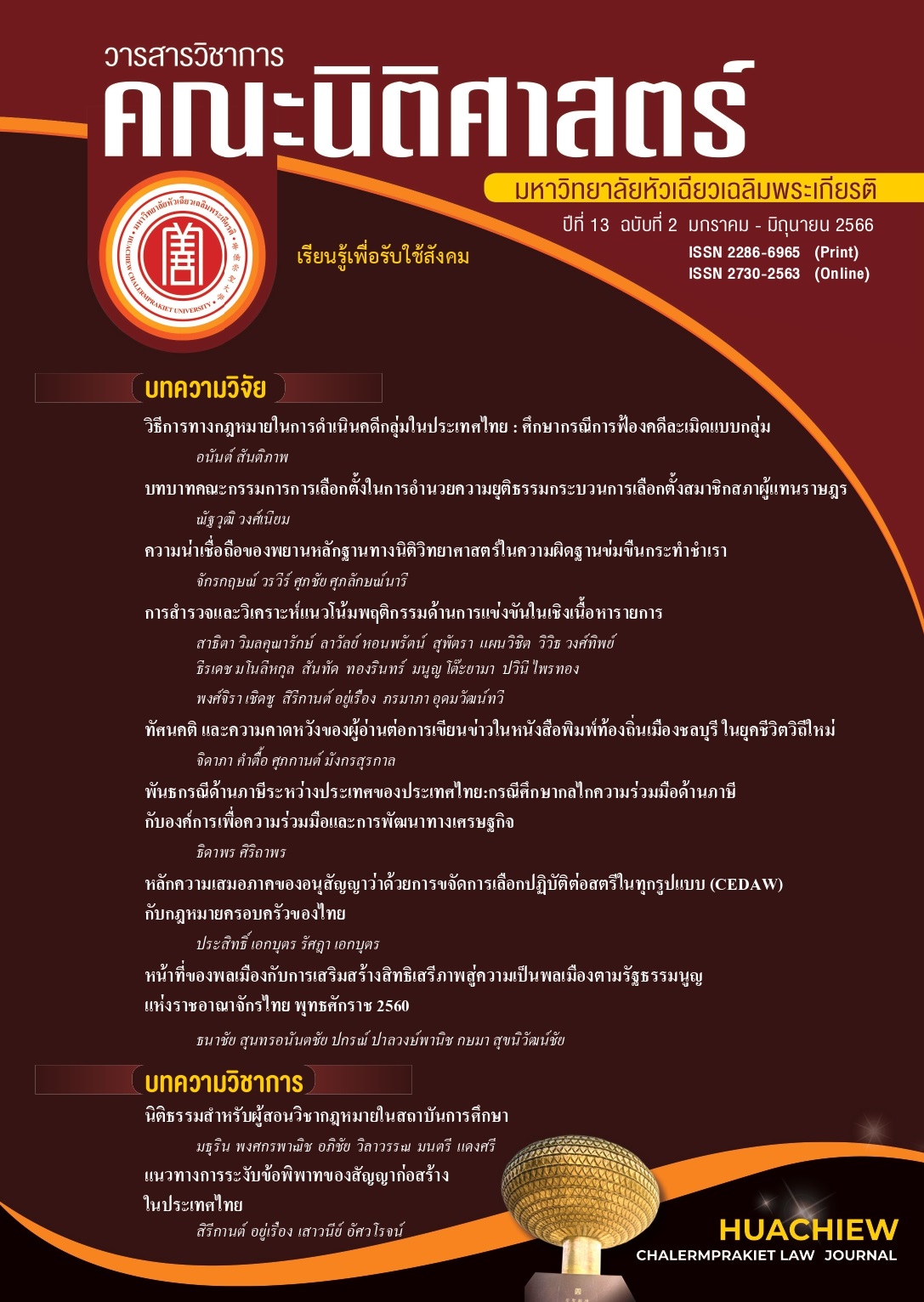The credibility of forensic evidence in rape offenses
Keywords:
rape, forensic evidence, criminal justiceAbstract
This article is a part of research on “The use of forensic evidence in criminal justice case processing of rape cases”. Forensic evidence is crucial in proving the facts of a case. However, there are factors affecting the credibility of the evidence namely, (1) the loss and contamination of evidence at the crime scene, (2) the insufficiency of investigation personnel, (3) the delay in the examination of the victim, causing the loss of biological evidence, (4) the misinterpretation of the injury evidence in rape cases, (5) the lack of clear legal guidline and protocol in weighing forensic evidence (6) the lack of experienced and knowledgeable personnel working in the justice system (7) the lack of complete DNA database and (8) the negative attitude among criminal justice personnel towards the victim of rape. All of these issues affect the credibility of forensic evidence.
References
ไกรวุฒิ วัฒนสิน. “การศึกษาความท้าทายการปฏิบัติหน้าที่ของนายร้อยตำรวจหญิง” (2563) 5:7 วารสารสังคมศาสตร์และมานุษยวิทยาเชิงพุทธ วัดวังตะวันตก จังหวัดนครศรีธรรมราช 197.
ฐิติกา กิจพิพิธ. การประยุกต์ใช้ความรู้ทางชีววิทยาในงานนิติวิทยาศาสตร์ (26 พฤศจิกายน 2564) สาขาชีววิทยา สถาบันส่งเสริมการสอนวิทยาศาสตร์และเทคโนโลยี < http://biology.ipst.ac.th/?p=3314>.
พัชรา สินลอยมา. “การพัฒนารูปแบบการดำเนินงานด้านนิติวิทยาศาสตร์เพื่อใช้ในการสืบสวนอาชญากรรมในเขตพื้นที่ 3 จังหวัดชายแดนภาคใต้” (2558) 11:2 วารสารวิชาการ บัณฑิตวิทยาลัยสวนดุสิต 43.
พิชญาภร ภัทรจิรธนกุล. ความรู้และความเข้าใจของอาสาสมัครกู้ภัยสว่างประทีปศรีราชา จังหวัดชลบุรีเกี่ยวกับหลักฐานทางนิติเวชและนิติวิทยาศาสตร์ (วิทยานิพนธ์สาขาวิชานิติวิทยาศาสตร์ มหาวิทยาลัยศิลปากร, 2561).
ยุทธพงษ์ พงษ์สวัสดิ์. คําบรรยายวิชาการสืบสวนสอบสวน (คณะรัฐศาสตร์ มหาวิทยาลัยธรรมศาสตร์: กรุงเทพมหานคร, 2513).
วิวัฒน์ ตัณฑะพานิชกุล. นาโนเทคโนโลยีคลื่นลูกใหม่แห่งศตวรรษที่ 21 (กรุงเทพมหานคร: ฐานการพิมพ์, 2548).
รพีพัฒน์ ศรีศิลารักษ์ และ ธีระวัฒน์จันทึก. “ปัญหาอุปสรรคและแนวทางการพัฒนาประสิทธิภาพในการปฏิบัติงานของฝ่ายสอบสวนในระบบงานยุติธรรม” (2560) 8:1 วารสารวิชาการคณะนิติศาสตร์ มหาวิทยาลัยหัวเฉียวเฉลิมพระเกียรติ 1.
รัชดาภรณ์ น้อยแก้ว และ วรธัช วิชชุวาณิชย์. “การศึกษาความสำคัญของพยานหลักฐานทางนิติวิทยาศาสตร์และการนำไปใช้ประโยชน์ในคดีอาญา: กรณีศึกษาสถานีตำรวจภูธรในพื้นที่จังหวัดสตูล” (2563) 6:2 วารสารวิชาการอาชญาวิทยาและนิติวิทยาศาสตร์ โรงเรียนนายร้อยตำรวจ 167.
รัชนี แตงอ่อน และ เจนวิทย์ นวลแสง. “กระบวนการยุติธรรมทางอาญาและฐานข้อมูลดีเอ็นเอแห่งชาติ: ประสบการณ์ประเทศสมาชิกสหภาพยุโรป” (2559) 8:1 วารสารการเมือง การบริหาร และกฎหมาย 459.
ศิรินรัตน์ ขันแก้ว และ วิชชุ วาณิชย์, “การรับฟังและชั่งน้ำหนักพยานหลักฐานทางนิติวิทยาศาสตร์จากคำพิพากษาศาลฎีกา” (2559) 6:1 วารสารวิชาการอาชญาวิทยาและนิติวิทยาศาสตร์ โรงเรียนนายร้อยตำรวจ ปีที่ 6 105.
วราภรณ์ พรหมวิกร, สุธิดา สุวรรณรังสี, ไกรสร อัมมวรรธน์, สุนทรี บูชิตชน และน้ำแท้ มีบุญสล้าง. “ความน่าเชื่อถือของพยานหลักฐานทางนิติวิทยาศาสตร์ : ปัญหา สาเหตุ และแนวทางการพัฒนาสำหรับประเทศไทย” (2559) 12:2 วารสารเทคโนโลยีภาคใต้ วิทยาลัยเทคโนโลยีภาคใต้ 168.
วิวัฒน์ ตัณฑะพานิชกุล. นาโนเทคโนโลยีคลื่นลูกใหม่แห่งศตวรรษที่ 21 (กรุงเทพมหานคร: ฐานการพิมพ์, 2548)
วิภู วิมลเศรษฐ และ ศิริรัตน์ ชูสกุลเกรียง. “ฐานข้อมูลสารพันธุกรรมในประเทศไทย” (2563) 13:3 วารสารกระบวนการยุติธรรม สำนักงานกิจการยุติธรรม 61.
วีระพงษ์ บุญโญภาส, สุพัตรา แผนวิชิต. “แนวทางการพัฒนาระบบการบริหารจัดการคดีในสถานีตำรวจ” (2558) 7:2วารสารการเมือง การบริหาร และกฎหมาย มหาวิทยาลัยบูรพา 33.
อติภา เนาวกิตตินาถ. “ปัญหาและอุปสรรคการพัฒนาสมรรถนะของพนักงานสอบสวน สํานักงานตํารวจแห่งชาติ” (2564) 7:1 วารสารวิชาการ สถาบันเทคโนโลยีแห่งสุวรรณภูมิ 668.
Benjamin Hine and AnthonyMurphy. “The impact of victim-perpetrator relationship, reputation and initial point of resistance on officers' responsibility and authenticity ratings towards hypothetical rape cases” (2017) 49:1 Journal of Criminal Justice n 1.
Cossins Annie. “Cross-examination in child sexual assault trials: Evidentiary safeguard or an opportunity to confuse?” (2009) 33:1 Melbourne University Law Review n 18.
Gerd Bohner, Friederike Eyssel, Afroditi Pina, Frank Siebler and G. Tendayi Viki. Rape myth acceptance: cognitive, affective and behavioural effects of beliefs that blame the victim and exonerate the perpetrator (Challenging Contemporary Thinking , Horvath, M. and Brown, J. (Eds.). Cullompton: Willan, 2009) n 17.
Graeme Walker. “The (in)significance of genital injury in rape and sexual assault” (2015) 34:1 Journal of Forensic and Legal Medicine n 173.
Hannah McGee, Madeleine O’Higgins, Rebecca Garavan and Ronán Conroy. “Rape and child sexual abuse: what beliefs persist about motives, perpetrators, and survivors”(2011) 26:17 J. Interpers Violence n 3580.
Iain McLean, Stephen A. Roberts, Cath White and Sheila Paul. “Female genital injuries resulting from consensual and non-consensual vaginal intercourse” (2011) 204:1 Forensic Science International n 27.
Jessica Kennedy, Patricia Easteal and Lorana Bartels. “How protected is she? “Fairness” and the rape victim witness in Australia” (2012) 3:5 Women's Studies International n 334.
Jennifer Temkin, New Crim Law Rev. “And always keep a-hold of nurse, for fear of finding something worse” (2010) 13:4 Challenging rape myths in the courtroom n 710.
Joseph L. Peterson, Matthew J. Hickman, Kevin J. Strom and Donald J. Johnson. “Effect of Forensic Evidence on Criminal” (2012) 58:5 Journal of Forensic Sciences n 1.
Kennedy KM. “The relationship of victim injury to the progression of sexual crimes through the criminal justice system” (2012) J Forensic Leg Med n 309.
Kieran M. Kennedy. “Heterogeneity of existing research relating to sexual violence, sexual assault and rape precludes meta-analysis of injury data” (2013) 20:5 Journal of Forensic and Legal Medicine n 447.
M. Kayser and A. Sajantila. “Mutations at Y-STR loci: implications for paternity testing and forensic analysis” (2001) 18:1 Forensic Sci n 116.
Margaret J McGregor, Janice Du Mont and Terri L Myhr. “Sexual assault forensic medical examination: Is evidence related to successful prosecution?” (2002) 39:6 Ann Emerg Med n 39.
Michael Lynch. “Science, truth, and forensic cultures: The exceptional legal status of DNA evidence”(2013) Studies in History and Philosophy of Science Part C: Studies in History and Philosophy of Biological and Biomedical Sciences n 60.
Samuel T.G. Ferreiraa, Karla A. Paula, Flávia A. Maia, Arthur E. Svidizinski, Marinã R. Amaral, Silmara A. Diniz, Maria E. Siqueira, Adriana V. Moraes, Leonor Gusmão and Lutz Roewer. “Routine analysis of sexual assault cases in Brasília, Brazil, using 23 Y chromosomal markers”. (2015) 5:1 Forensic Science International: Genetics Supplement n 615.
State v. Williams. Court of Appeals of Ohio, Fifth Appellate District, Stark County, Date of Judgment Entry. Case No. 2017 CA 00078 (May 21, 2018).
State v. Durdin. Court of Appeals of Ohio, Tenth Appellate District Rendered, Case No. 14AP-249 (December 30, 2014).
Z.Jakovskia, R.Jankova, A. Duma, B.Janeska, G.Pavlovski and D. Marjanovic. Forensic Approach to analyzing rape cases. (Forensic Science International: Genetics Supplement Series 4) n 45.
Downloads
Published
How to Cite
Issue
Section
License
Copyright (c) 2023 Huachiew Chalermprakiet Law Journal

This work is licensed under a Creative Commons Attribution-NonCommercial-NoDerivatives 4.0 International License.
บทความหรือข้อความคิดเห็นใด ๆ ที่ปรากฏในวารสารฉบับนี้เป็นวรรณกรรมของผู้เขียนโดยเฉพาะ คณะนิติศาสตร์มหาวิทยาลัยหัวเฉียวเฉลิมพระเกียรติ และกองบรรณาธิการไม่มีส่วนรับผิดชอบหรือไม่จำเป็นต้องเห็นด้วยกับข้อคิดเห็นนั้น แต่ประการใด








